*My posts may contain affiliate links, which means I may receive a small commission, at no cost to you, if you make a purchase through a link! Thank you for supporting my website!*
Last updated on February 28th, 2024 at 04:31 pm
Have you ever wondered if you can use an orbital or palm sander to sand between coats of polyurethane?
I wondered the same thing because it seems like it would save so much time! But I wasn’t sure, so I had to test this theory. Here is what I found:
An orbital or palm sander with 220 grit sandpaper creates a smooth finish in polyurethane, but it leaves behind a thin, easily scratched finish in the polyurethane. Hand sanding provides better control over how much polyurethane is sanded off, which also creates a smooth finish with more durability.
Below, I recorded my entire experiment process, so you can see how I found these results, and you can determine whether hand sanding or sanding with an orbital/palm sander is right for your wood project.
Let’s dive on in!

Quick Navigation: What Happens When You Use An Orbital Sander Between Coats Of Polyurethane
- Sanding Polyurethane Using An Orbital/Palm Sander vs. Hand Sanding
- Final Results: Can You Use An Orbital (Or Palm) Sander Between Coats Of Polyurethane
- How To Avoid Bubbles In Polyurethane From The Start
- Do You Sand The Final Coat Of Polyurethane?
- Final Thoughts
Sanding Polyurethane Using An Orbital/Palm Sander vs. Hand Sanding
To run this experiment, I stained two pieces of pine wood and applied 3 coats total of polyurethane. Between each coat of polyurethane, I used 220 grit sandpaper to sand before applying another coat of polyurethane.
For the hand-sanded piece, I used a normal 220 grit sanding block. And for the palm-sanded piece, I used this DeWalt palm sander found at Amazon. It is an excellent beginner mechanical sander because it is cheaper and gets the job done.
Although, in the future, I plan to get a more commercial-grade quality sander to cut my sanding time down significantly. This DeWalt palm sander does the job for now, though, and I’m glad I learned how to use a mechanical sander by using this one.
Here are the finish, durability, and texture comparisons of the polyurethane after I sanded between each coat:
| Sanding Type | Finish | Texture | Durability |
|---|---|---|---|
| Orbital/Palm Sanding | Splotchy coverage | Extra Smooth | Easy To Scratch* |
| Hand Sanding | Uniform coverage | Smooth | Hard To Scratch* |
Finish
First, let’s talk about the finish. When I started this experiment, I really thought that the finish difference was going to be obvious. I was expecting the palm sander to eat through the polyurethane immediately, and I’d never get enough good coats on.
I was surprised to see that the polyurethane was still there on the palm-sanded piece, but it definitely was thinner than the hand-sanded version at each coat.
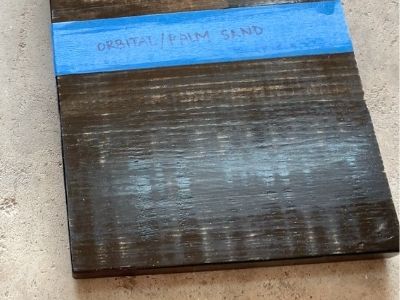
This is because there was no way for me to control the amount of pressure placed on the palm-sanded piece of wood. (I even tried to put hardly any pressure on the palm sander and just the weight of it sit on the wood while it sanded.) Whereas for hand-sanding, I could start lightly and apply more pressure as needed.
Because I couldn’t apply the pressure evenly when a palm sander, the final polyurethane coat turned out splotchy in certain lighting.
It didn’t feel splotchy or uneven to the touch, but in certain lighting, it looked like I only applied one coat of polyurethane in random spots. Definitely not ideal for a flawless polyurethane finish.
The hand-sanded piece, on the other hand, had an even, uniform coverage of polyurethane.

It definitely smoothed out any minor unevenness between the coats of polyurethane, left the stain completely intact, and left a thicker layer of polyurethane behind.
This round goes to hand-sanding.
Score:
- Hand-sanding: 1
- Orbital/palm sanding: 0
Texture
Second, we need to discuss texture.
For the palm-sanded piece of wood, the texture of the finish was slightly smoother than the hand-sanded piece.

That shocked me! It almost made me say that palm sanding between coats of polyurethane is the way to go. Even with the slight splotchy appearance of the finish, you couldn’t feel that splotchiness at all.
In fact, it felt so smooth, I felt like I could have passed it off as a store-bought finish.
The hand-sanded piece, on the other hand, was still significantly smoother than if I had not sanded between coats.
(I actually ran an experiment on what happens if you don’t sand between coats of polyurethane. You need to check out the results here, so that you don’t waste your valuable time!)
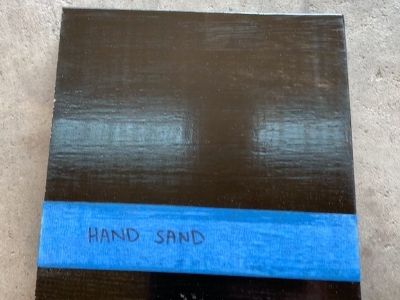
It had a slightly less smooth texture to it, but it was still smooth enough for me to say that it had a quality finish on it.
This round, I’ve gotta give the point to orbital or palm sanding.
Score:
- Hand-sanding: 1
- Orbital/palm sanding: 1
Durability
Third, we need to discuss durability.
For the palm-sanded piece of wood, I could tell that I didn’t have all 3 of my layers of polyurethane left.

The palm sander was a little rougher with how much it took off, so while this finished piece felt smoother, it wasn’t as durable.
I could easily scratch the wood just like I would be able to if I had only applied one coat of polyurethane.
On the other hand, the hand-sanded piece definitely had all 3 layers left to it. I couldn’t scratch it with my fingernail, so it was more durable in the end.
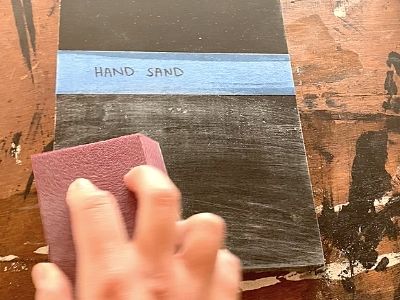
That will make the hand-sanded piece last significantly longer than the palm-sanded piece.
For this round, the point goes to hand-sanding.
Score:
- Hand-sanding: 2
- Orbital/palm sanding: 1
Final Results: Can You Use An Orbital (Or Palm) Sander Between Coats Of Polyurethane
After all three of these tests, I’m not confident that I could get a good polyurethane finish by using an orbital or palm sander between coats.
Final Score:
- Hand-sanding: 2
- Orbital/palm sanding: 1
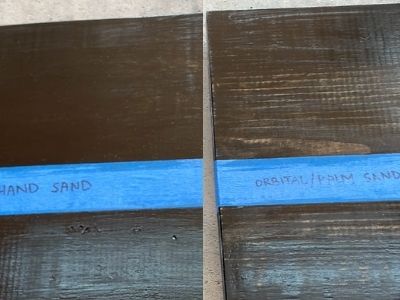
The hand sanding does exactly what I’d ever need it to do if I had to sand between coats. (Oftentimes, I don’t even do that. Only if I have drips or clear uneven marks throughout my polyurethane.)
It truly doesn’t take much more time to hand-sand between coats compared to an orbital or palm sander, and the finish and durability turn out much better when I do hand-sand.
To sum it up, I believe using an orbital or palm sander with 220 grit sandpaper between coats of polyurethane is too rough to get a good polyurethane finish.
(It’s always worth trying 400 grit sandpaper or higher to see if the outcome is different though!)
How To Avoid Bubbles In Polyurethane From The Start
Since we’ve been talking about getting a flawless polyurethane finish, you need to check out my article on how to fix bubbles in polyurethane (and other polyurethane mistakes to avoid).
In that article, I’ll help you fix (and avoid!) those annoying bubbles that sometimes appear while applying your topcoat.
I always love time saving tips, and that article certainly checks the box haha!
Do You Sand The Final Coat Of Polyurethane?
I also ran a test to finally determine whether you should sand the final coat of polyurethane or not. You can check out the results here to aid in your journey to that perfect polyurethane finish!
Final Thoughts On Using An Orbital Sander To Sand Between Coats Of Polyurethane
There you have it! Orbital or palm sanders are a little rougher on the topcoat than I would like them to be.
Take that knowledge as a win because now you don’t have to worry about whether your orbital sander will eat through the topcoat of your beautiful wood project!
You can quickly and lightly hand-sand and move on with the final steps of your project. Score!
Catch you in my next post!
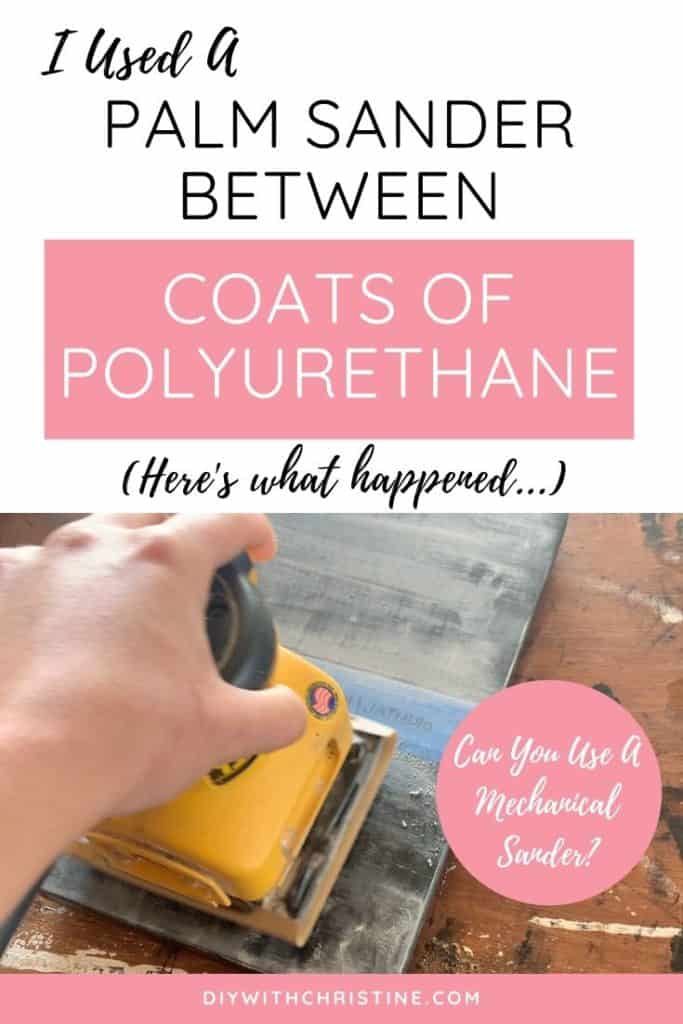

By Christine
Christine is a blogger and DIYer who tackles home renovation and decorating projects alongside her husband, Adam, for their personal residence and rental properties. Although she successfully tackles large renovation projects to avoid expensive contractor fees and bring her vision to life now, her path to success was not easy.
Go here to read her story, “From a Clueless First-Time Homebuyer To A Confident DIYer Creating Her Dream Home One Project At A Time“.
Popular Posts
DIY With Christine is a participant in the Amazon Services LLC Associates Program, an affiliate advertising program designed to provide a means for sites to earn advertising fees by advertising and linking to Amazon.com.





